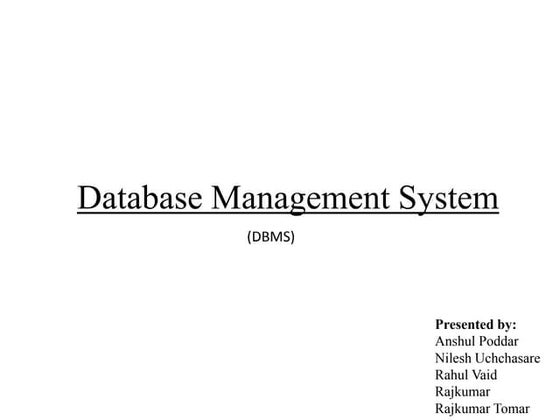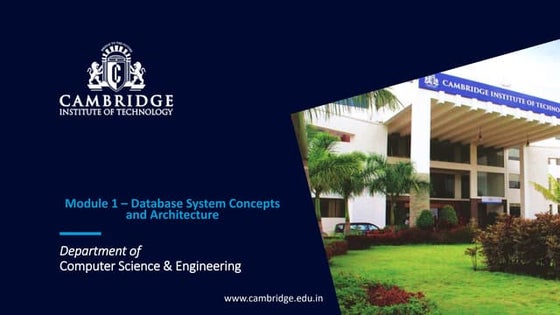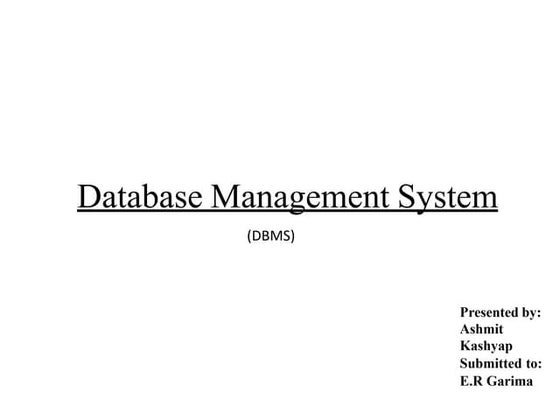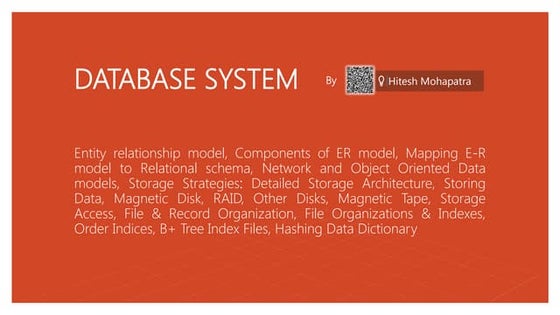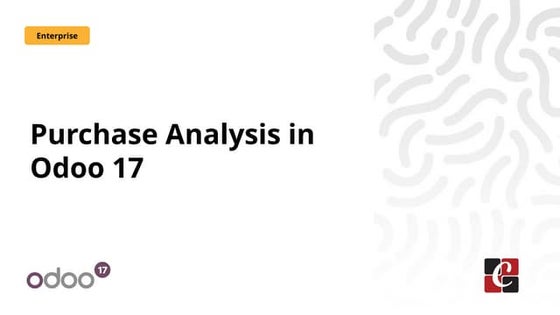introduction-to-dbms-unit-1.ppt
- 2. Course Objectives ŌĆó To understand purpose of database management system ŌĆó Apply concepts like database design and database languages in managing data ŌĆó Importance of normalization in dbms and SQL in implementation of database access ŌĆó Knowledge of transaction control , recovery strategies , storage and indexing etc
- 4. Text Book 1.Database Management Systems, Raghurama Krishnan, Johannes Gehrke (2007), 3rd Edition, Tata McGraw-Hill, New Delhi, India 2.Database System Concepts Abraham Silberschatz, Henry F. Korth, S. Sudarshan (2010), 6th Edition, McGraw-Hill, New Delhi, India.
- 6. Roles ŌĆó Data Engineer ŌĆó Data Scientist etc
- 7. History of database systems ŌĆó Integrated Data Store, First general purpose DBMS by charles bachman at General Electric.[Network Model] ŌĆó IBMŌĆÖs Information Management System(IMS)[hierachial data model] ŌĆó SABRE system for making airline reservations By American airlines and IBM ŌĆó In 1970,at IBMŌĆÖs San Jose Research laboratory proposed relational data model ŌĆó In 1980ŌĆÖs, SQL for relational databases by IBM ŌĆó Database transaction management james gray 1999 ŌĆó IBMŌĆÖs DB2, Oracle 8, Informix UDS ŌĆó ERP and MRP ŌĆó DBMS with internet ŌĆó Multimedia databases, streaming data, digital libraries ,NASAŌĆÖs earth observation system project ŌĆó Decision making and mining data repositories
- 8. Introduction to database management systems ŌĆó Data: Data represents known facts or raw information in unorganized form (such as alphabets or numbers or symbols ) . ŌĆó Database: Database is a organized collection of data describing the activities of one or more related organizations. ŌĆó Database management system(DBMS) is a software designed to assist in storing, maintaining and utilizing large collections of data. or A database-management system (DBMS) is a computer-software application which interacts with end-users, other applications, and the database itself to access,update,manage and analyze data with the help of set of application programs.
- 9. Advantages of Database management systems ŌĆó Data Independence ŌĆó Efficient data access ŌĆó Data integrity and security ŌĆó Data administration ŌĆó Concurrent access and crash recovery ŌĆó Reduced application development time
- 11. Database systems Vs file systems ŌĆó File storage refers to a collection of operating system files. ŌĆó DBMS features to manage the data in a robust and efficient manner.
- 12. Advantages of dbms over file system ŌĆó No redundant data ŌĆō Redundancy removed by data normalization ŌĆó Data Consistency and Integrity ŌĆō data normalization takes care of it too ŌĆó Secure ŌĆō Each user has a different set of access ŌĆó Privacy ŌĆō Limited access ŌĆó Easy access to data ŌĆó Easy recovery ŌĆó Flexible
- 13. View of data ŌĆó Abstraction ŌĆó Data Abstraction ŌĆó Instance and schema
- 14. ŌĆó Abstraction :Hiding unnecessary details from the user and providing abstract view of data which is required to users. ŌĆó Data Abstraction: Database systems are made-up of complex data structures. To ease the user interaction with database, the developers hide internal irrelevant details from users. This process of hiding irrelevant details from user is called data abstraction.
- 15. Schema ŌĆó Design of a database is called schema. ŌĆó 3 types: ŌĆō Physical schema ŌĆō Logical schema ŌĆō View schema
- 16. Data models ŌĆó Data models determines the logical structure of a database ŌĆó A Data Model is a logical structure of Database. It describes the design of database to reflect entities, attributes, relationship among data, constrains etc.
- 17. Data models ŌĆó Relational data model ŌĆó Entity ŌĆō relationship model ŌĆó Hierarchical data model ŌĆó Network model ŌĆó Object oriented model ŌĆó Object relational model ŌĆó Semi structured data model ŌĆó Flat data model
- 18. Hierarchical data model ŌĆó A hierarchical database model is a data model in which the data is organized into a tree-like structure. The data is stored as records which are connected to one another through links. ŌĆó A record is a collection of fields, with each field containing only one value.
- 19. Example for hierarchical model
- 20. Example of hierarchical model
- 22. Network model ŌĆó In the network model, entities are organized in a graph, in which some entities can be accessed through several paths.
- 23. Network data model example
- 24. Example for network model
- 25. Object oriented data model ŌĆó This data model is another method of representing real world objects. ŌĆó It considers each object in the world as objects and isolates it from each other. ŌĆó It groups its related functionalities together and allows inheriting its functionality to other related sub-groups.
- 27. Object relational data model ŌĆó An object-relational database (ORD), or object-relational database management system (ORDBMS), is a database management system (DBMS) similar to a relational database, but with an object-oriented database model: objects, classes and inheritance are directly supported in database schemas and in the query language
- 28. Semi structured data model: The semi-structured data model is designed as an evolution of the relational data model that allows the representation of data with a flexible structure. Semi-structured data model is model where schema is part of data
- 32. ŌĆó Select ŌĆō Unique ŌĆō Distinct ŌĆō Count ŌĆō As ŌĆō In ŌĆō Sum ŌĆō IS NULL ŌĆō IS NOT NULL ŌĆō ORDER BY ŌĆō AND, OR
- 33. Database users and administration ŌĆó Database users 1. Application Programmers 2. Sophisticated users 3. Specialized users 4. Stand-alone users 5. Native Users
- 34. Database administrators ŌĆó Responsibilities of DBA: ŌĆō Installing and upgrading DBMS servers ŌĆō Design and implementation of databases ŌĆō Schema definition , storage structure, access method definition ŌĆō Performance Tuning ŌĆō Migrate database servers ŌĆō Backup and recovery ŌĆō Security ŌĆō Documentation etc
- 35. Types of database administrators ŌĆó Administrative DBA ŌĆó Development DBA ŌĆó Database Architect ŌĆó Data warehouse DBA ŌĆó Application DBA ŌĆó OLAP DBA
- 36. Transaction management ŌĆó Transaction ŌĆó Partial transactions ŌĆó Concurrent execution of transactions ŌĆó Locking protocol ŌĆó Locks ŌĆó Shared locks ŌĆó Exclusive locks ŌĆó Incomplete transactions ŌĆó System crashes ŌĆó Log ŌĆó Write Ahead Log (WAL) ŌĆó Checkpoint ŌĆó Periodic checkpoints
- 37. Introduction to database design Database design process steps ŌĆó Requirement Analysis ŌĆó Conceptual database design ŌĆó Logical database design ŌĆó Schema refinement ŌĆó Physical database design ŌĆó Application and security design
- 38. E -R diagrams ŌĆó The E-R data model allows us to describe the data involved in a real-world enterprise in terms of objects and their relationships and is widely used to develop an initial database design.
- 39. entities ŌĆó An entity is an object in the real world that is distinguishable from other objects. ŌĆó An Entity can be any object, place, person or class. ŌĆó an entity is represented using rectangles. Employee Department Works for
- 40. Weak entity Weak entity is an entity that depends on another entity. Weak entity doesn't have key attribute of their own. Double rectangle represents weak entity.
- 41. attributes ŌĆó An Attribute describes a property or characteristic of an entity. For example, Name, Age, Address etc can be attributes of a Student. An attribute is represented using eclipse
- 42. Types of attributes ŌĆó Key attribute ŌĆó Composite attributes ŌĆó Derived attributes
- 43. relationships ŌĆó A Relationship describes relations between entities. Relationship is represented using diamonds ŌĆó Relationship is an association among 2 or more entities ŌĆó There are three types of relationship that exist between Entities. ŌĆó Binary Relationship ŌĆó Recursive Relationship ŌĆó Ternary Relationship
- 44. relationship sets ŌĆó Collection of set of similar relationships is called a relationship set.
- 45. additional features of the E -R model ŌĆó Key constraints ŌĆó Key constraints for ternary relationships ŌĆó Participation constraints(partial and complete) ŌĆó Class hierarchies ŌĆó Aggregation
- 46. conceptual design with the E-R model ŌĆó Entity versus attribute ŌĆó Entity versus relationship ŌĆó Binary versus ternary relationships ŌĆó Aggregation versus ternary relationships
- 47. conceptual design for large enterprises
- 48. ŌĆó A college contains many departments ŌĆó Each department can offer any number of courses ŌĆó Many instructors can work in a department ŌĆó An instructor can work only in one department ŌĆó For each department there is a Head ŌĆó An instructor can be head of only one department ŌĆó Each instructor can take any number of courses ŌĆó A course can be taken by only one instructor ŌĆó A student can enroll for any number of courses ŌĆó Each course can have any number of students
- 49. ŌĆó Step 1 : Identify the Entities ŌĆó Stem 2 : Identify the relationships ŌĆó Step 3: Identify the key attributes ŌĆó Step 4: Identify other relevant attributes ŌĆó Step 5: Draw complete ER diagram
- 50. ŌĆó Step 1 : Identify the Entities What are the entities here? From the statements given, the entities are ŌĆó Department ŌĆó Course ŌĆó Instructor ŌĆó Student
- 51. Stem 2 : Identify the relationships ŌĆó One department offers many courses. But one particular course can be offered by only one department. hence the cardinality between department and course is One to Many (1:N) ŌĆó One department has multiple instructors . But instructor belongs to only one department. Hence the cardinality between department and instructor is One to Many (1:N) ŌĆó One department has only one head and one head can be the head of only one department. Hence the cardinality is one to one. (1:1) ŌĆó One course can be enrolled by many students and one student can enroll for many courses. Hence the cardinality between course and student is Many to Many (M:N) ŌĆó One course is taught by only one instructor. But one instructor teaches many courses. Hence the cardinality between course and instructor is Many to One (N :1)
- 52. ŌĆó Step 3: Identify the key attributes ŌĆó "Departmen_Name" can identify a department uniquely. Hence Department_Name is the key attribute for the Entity "Department". ŌĆó Course_ID is the key attribute for "Course" Entity. ŌĆó Student_ID is the key attribute for "Student" Entity. ŌĆó Instructor_ID is the key attribute for "Instructor" Entity.
- 53. ŌĆó Step 4: Identify other relevant attributes ŌĆó For the department entity, other attributes are location ŌĆó For course entity, other attributes are course_name,duration ŌĆó For instructor entity, other attributes are first_name, last_name, phone ŌĆó For student entity, first_name, last_name, phone
- 56. ŌĆó A typical example could be entities Customer, Order, and Product. ŌĆó An instance of the Customer entity is identified by a unique customer number, ŌĆó an instance of the Order entity is identified by a unique order number, and ŌĆó an instance of the Product entity is identified by a unique product number.
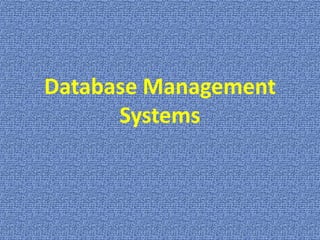





![History of database systems
ŌĆó Integrated Data Store, First general purpose DBMS by charles bachman at General
Electric.[Network Model]
ŌĆó IBMŌĆÖs Information Management System(IMS)[hierachial data model]
ŌĆó SABRE system for making airline reservations By American airlines and IBM
ŌĆó In 1970,at IBMŌĆÖs San Jose Research laboratory proposed relational data model
ŌĆó In 1980ŌĆÖs, SQL for relational databases by IBM
ŌĆó Database transaction management james gray 1999
ŌĆó IBMŌĆÖs DB2, Oracle 8, Informix UDS
ŌĆó ERP and MRP
ŌĆó DBMS with internet
ŌĆó Multimedia databases, streaming data, digital libraries ,NASAŌĆÖs earth observation
system project
ŌĆó Decision making and mining data repositories](https://image.slidesharecdn.com/introduction-to-dbms-unit-1-240123131108-834fffc9/85/introduction-to-dbms-unit-1-ppt-7-320.jpg)
























































